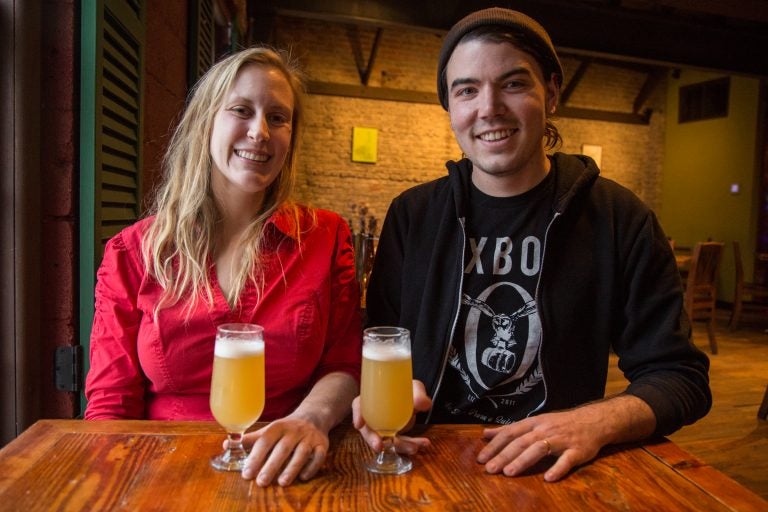Acquiring tastes: Ardmore brewers travel the world to savor craft beers
Jean Broillet IV and Julie Foster learn say they from the culture of other breweries — as well as their facilities and how they set up their businesses.
Listen 5:20
Julie Foster and Jean Broillet IV chat about beer trends at the cafe at their Tired Hands Brewery in Ardmore, Pennsylvania. (Emily Cohen for WHYY)
A good pour of beer over the holidays can be a tasty part of the cheer shared with family and friends. And some of us go to great lengths to get it.
Beer road trips are inspirational and recreational, and handy apps can point us in the right direction.
Ardmore brewers Jean Broillet IV and Julie Foster of Tired Hands have traveled the world in search of craft beers that offer something different. They shared some thoughts with “Morning Edition” host Jennifer Lynn.
—
Julie, what’s your experience getting around and getting to taste beers from our region or even outside of our region?
Julie Hoster: Jean and I have traveled all over the world to try different breweries, pretty much ever since the day we met. It’s been an invaluable experience. Every brewery is a little bit different. We get to enjoy learning from the culture of other breweries as well as their facilities, how they set up their businesses.
Before we sat down today, one of you mentioned that you put a big group of your employees in a big van and took a road trip. What did you do? Where did you go? And who went?
Jean Broillet: So, when we were a much smaller company, we used to take field trips as a group. Now that we employ right around 100 people, we take departmental field trips. I decided to blow it out this year, so we rented a 15-passenger van, and every single member of our brewing staff hopped in, and we took a road trip up to Maine. [We] spent a really nice weekend without power in the woods of Newcastle, maine, and brewed beer via a generator.
What was the takeaway of that trip in terms of what you tasted, things that were different about that scene?
JB: Man, they are laid back up there. The guys there are big into native yeast and bacteria to create a beer that is really unique to their area, which was a big takeaway for me.
Well, I, myself have have gone around a little bit this year in particular to some breweries: Adamstown, Philadelphia, Ephrata, all the way down to Cambridge, Maryland, to try a place called RAR. It’s a pretty neat little spot. And, for me, it’s freshness. What about for you, Julie?
JH: That’s what’s really exciting about going to the place where a beer is produced. It’s the indigenous ingredients. It’s the indigenous culture. As you mentioned, it’s the freshness. There’s something about experiencing a thing that is of its place that is really important and valuable.
I want to talk about bringing stuff back. That’s so easy now through growlers, through canning.
JH: Check a suitcase. (Laughter)
Have you ever done that? Filled a suitcase with beer?
JH: Yeah. Bring lots of Ziploc bags. Rick Steves always recommends bringing some rubber bands and plastic bags, and that works pretty well.
What goes into the expense of beer these days?
JB: A lot of small producers that are making a premium product are using premium ingredients. And they’re taking all the time necessary to condition that beer. Time is money in this industry, and certainly hops aren’t getting any cheaper. So especially if you’re dealing with canned IPA, they are fetching a pretty decent price these days because producers are adding a lot of this very expensive ingredient, hops.
There’s a trend right now of adding a whole lot of sort of superfluous ingredients that are quite expensive — namely, vanilla beans, which have spiked something like 50 percent over the past six months in price — so all of those ingredients are going to cost a good bit of money.
There are beer forums and certainly apps available to help us find beers and breweries. How good are these tools, Jean, or is word of mouth best?
JB: I think the whole premise of our conversation today, traveling and experiencing for yourself, is the best course. There are a lot of subcultures that kind of dictate rare is best, expensive is best, and hard to get is best. And that can kind of skew the consumer or guest’s opinion of what is good and what is bad. I would really advocate that people who are truly interested in craft beer travel and experience and smell and taste and just get a sense of place for themselves.
I guess people can even save themselves the time and miles. Can you even get beer on eBay these days?
JH: Not legally.
OK, so I don’t know anyone’s who’s done that.
JH: It’s a problem that folks are trying to address, and it goes back to the freshness point that you made. When you are buying beer that’s been shipped outside of its place of origin, you have no idea how it has been handled. Sometimes brewers don’t even package-date their beer, so you don’t know how old that beer is. And it’s unlikely that it’s being cold-shipped unless you are going through actually a formal, legal distributing process.
Jean, what makes a brewery and its products highly regarded?
JB: I think all accolades are kind of predicated on the integrity of the producers and the institution and really what they have to give back to their culture. It’s the classic “art is hard” dynamic. Yeah. Art is hard, and if you just copy someone else’s style, it’s not going to be hard, and you can sell a lot of beer. But if you are actively creating and innovating, you will be well-regarded in your community and in your industry.
JH: When we are talking about the integrity of an institution, that also includes how they treat their people and their community. So, hopefully, part of what you’re paying for, at least certainly in our case, is the labor and the love of the people who made it, who crafted it by hand. And that they’re getting paid a good living wage and benefits and that the institution is also contributing and giving back to the community.
WHYY is your source for fact-based, in-depth journalism and information. As a nonprofit organization, we rely on financial support from readers like you. Please give today.





